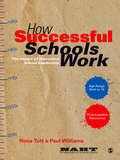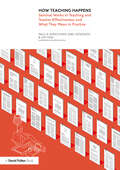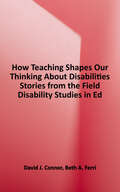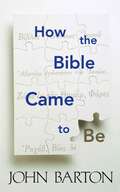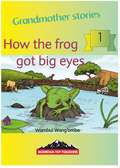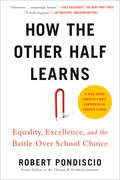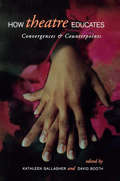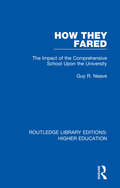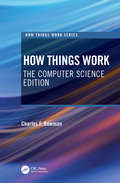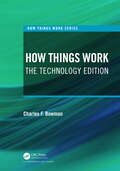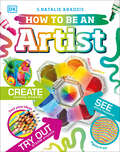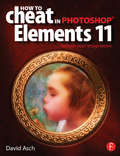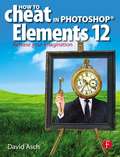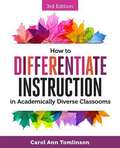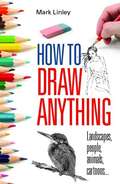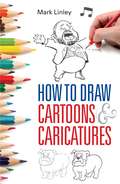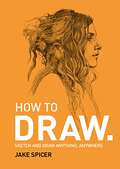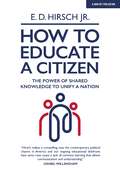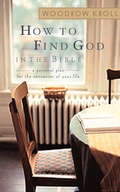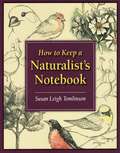- Table View
- List View
How Successful Schools Work: The Impact of Innovative School Leadership
by Paul Williams Rona TuttInside this book are case studies of cutting edge best practice from inspirational heads and school leaders doing excellent work in schools. They all illustrate how the role, and style, of school leadership is changing. By looking at what attracts teachers to leadership roles, and how they use their power, this book examines innovative leadership in action. The authors look at the characteristics of innovative school leaders, and reflect on how these people work. An appetite for challenge, a desire for a sense of well-being for all those involved in the school and its development and an ability to flex their style of leadership all emerge as core factors in their success. Topics covered include: - the changing role of school leaders - leading inclusive environments - the power of innovative leadership - identifying the challenges ahead The perfect read for anyone wanting to make a difference to their school or setting, this book will show you how it is done. Rona Tutt is Past President of the National Association of Headteachers, now working as an Educational Consultant. Paul Williams is a very experienced Head Teacher, based in London, who has held a number of leadership roles.
How Teaching Happens: Seminal Works in Teaching and Teacher Effectiveness and What They Mean in Practice
by Carl Hendrick Paul A. Kirschner Jim HealBuilding on their bestselling book How Learning Happens, Paul A. Kirschner and Carl Hendrick are joined by Jim Heal to explore how teaching happens. The book seeks to closely examine what makes for effective teaching in the classroom and how research on expert teaching can be used in practice. Introducing 30 seminal works from the field of education psychology research, the learning sciences, and teaching effectiveness studies, each chapter takes an important work and illustrates clearly and concisely what the research means and how it can be used in daily practice. Divided into six sections the book covers: • Teacher Effectiveness, Development, and Growth • Curriculum Development / Instructional Design • Teaching Techniques • Pedagogical Content Knowledge • In the Classroom • Assessment The book ends with a final chapter on "What’s Missing?" in how teachers learn to teach. Written by three leading experts in the field with illustrations by Oliver Cavigioli, How Teaching Happens provides a clear roadmap for classroom teachers, school leaders, and teacher trainers/trainees on what effective teaching looks like in practice.
How Teaching Shapes Our Thinking about Disabilities: Stories from the Field (Disability Studies In Education #Book Twenty-Six)
by David J. Connor Beth A. FerriThis book purposefully connects practice to research, and vice versa, through the use of deeply personal stories in the form of autoethnographic memoirs. In this collection, twenty contributors share selected tales of teaching students with dis/abilities in K-12 settings across the USA, including tentative triumphs, frustrating failures, and a deep desire to understand the dynamics of teaching and learning. The authors also share an early awareness of significant dissonance between academic knowledge taught to them in teacher education programs and their own experiential knowledge in schools. Coming to question established practices within the field of special education in relation to the children they taught, each author grew increasingly critical of deficit-models of disability that emphasized commonplace practices of physical and social exclusion, dysfunction and disorders, repetitive remediation, and punitive punishments. <p><p>The authors describe how their interactions with children and youth, parents, and administrators, in the context of their classrooms and schools, influenced a shift away from the limiting discourse of special education and toward become critical special educators and/or engage with disability studies as a way to reclaim, reframe, and reimagine disability as a natural part of human diversity. Furthermore, the authors document how these early experiences in the everydayness of schooling helped ground them as teachers and later, teacher educators, who galvanized their research trajectories around studying issues of access and equality throughout educational structures and systems, while developing new theoretical models within Disability Studies in Education, aimed to impact practices and policies.
How The Bible Came To Be
by John BartonIn a clear and concise way, John Barton describes the development of the Bible. He explains how the Bible came to be written and collected into the authoritative Scriptures of the Christian Church. Barton untangles the web of history and lets the reader appreciate the journey from spoken word to written word.
How The Frog Got Big Eyes
by Wambui Wang'Ombe"One day the frog was hopping around.”One two three,...... hop, four five six jumps, seven eight--!!” The frog hit an object. “Ouch! What is this?”
How The Other Half Learns: Equality, Excellence, and the Battle Over School Choice
by Robert PondiscioAn inside look at America's most controversial charter schools, and the moral and political questions around public education and school choice.The promise of public education is excellence for all. But that promise has seldom been kept for low-income children of color in America. In How the Other Half Learns, teacher and education journalist Robert Pondiscio focuses on Success Academy, the network of controversial charter schools in New York City founded by Eva Moskowitz, who has created something unprecedented in American education: a way for large numbers of engaged and ambitious low-income families of color to get an education for their children that equals and even exceeds what wealthy families take for granted. Her results are astonishing, her methods unorthodox.Decades of well-intended efforts to improve our schools and close the "achievement gap" have set equity and excellence at war with each other: If you are wealthy, with the means to pay private school tuition or move to an affluent community, you can get your child into an excellent school. But if you are poor and black or brown, you have to settle for "equity" and a lecture--about fairness. About the need to be patient. And about how school choice for you only damages public schools for everyone else. Thousands of parents have chosen Success Academy, and thousands more sit on waiting lists to get in. But Moskowitz herself admits Success Academy "is not for everyone," and this raises uncomfortable questions we'd rather not ask, let alone answer: What if the price of giving a first-rate education to children least likely to receive it means acknowledging that you can't do it for everyone? What if some problems are just too hard for schools alone to solve?
How Theatre Educates
by Kathleen Gallagher David BoothCanada boasts a remarkable number of talented theatre artists, scholars, and educators. How Theatre Educates brings together essays and other contributions from members of these diverse communities to advocate for a broader and more inclusive understanding of theatre as an educative force.Organized to reflect the variety of contexts in which professionals are making, researching, and teaching drama, this anthology presents a wide range of articles, essays, reminiscences, songs, poems, plays, and interviews to elucidate the relationship between theatre practice and pedagogy, and to highlight the overriding theme: namely, that keeping 'education' - with its curriculum components of dramatic literature and theatre studies in formal school settings - separate from 'theatre' outside of the classroom, greatly diminishes both enterprises.In this volume, award-winning playwrights, directors, actors, and scholars reflect on the many ways in which those working in theatre studios, school classrooms, and on stages throughout the country are engaged in teaching and learning processes that are particular to the arts and especially genres of theatre. Situating theatre practitioners as actors in a larger socio-cultural enterprise, How Theatre Educates is a fascinating and lively inquiry into pedagogy and practice that will be relevant to teachers and students of drama, educators, artists working in theatre, and the theatre-going public.ContributorsMaja ArdalDavid BoothPatricia CanoDiane FlacksKathleen GallagherJohn GilbertSky GilbertJim GilesLinda GriffithsTomson HighwayJanice HladkiCornelia HooglandAnn-Marie MacDonaldLori McDougallJohn MurrellDomenico PietropaoloWalter PitmanRichard RoseJason ShermanLynn SlotkinLarry SwartzJudith ThompsonGuillermo VerdecchiaBelarie Zatzman
How They Fared: The Impact of the Comprehensive School Upon the University (Routledge Library Editions: Higher Education #20)
by Guy NeaveOriginally published in 1975 How They Fared looks at some of the effects of ‘going comprehensive’. The book's investigation provides information about the inflow of students from comprehensive schools. In what way do these students differ from their fellows from selective establishments? What does this tell us about the relationship between school and university? Do comprehensive school students differ in in their reasons for entering higher education from the more ‘traditional’ pattern of university students? The book seeks to answer these questions by examining the effects of the changing pattern of secondary education upon the university.
How Things Work: The Computer Science Edition (How Things Work Series)
by Charles F. BowmanIt’s axiomatic to state that people fear what they do not understand, and this is especially true when it comes to technology. However, despite their prevalence, computers remain shrouded in mystery, and many users feel apprehensive when interacting with them. Smartphones have only exacerbated the issue. Indeed, most users of these devices leverage only a small fraction of the power they hold in their hands. How Things Work: The Computer Science Edition is a roadmap for readers who want to overcome their technophobia and harness the full power of everyday technology. Beginning with the basics, the book demystifies the mysterious world of computer science, explains its fundamental concepts in simple terms, and answers the questions many users feel too intimidated to ask. By the end of the book, readers will understand how computers and smart devices function and, more important, how they can make these devices work for them. To complete the picture, the book also introduces readers to the darker side of modern technology: security and privacy concerns, identity theft, and threats from the Dark Web.
How Things Work: The Technology Edition (How Things Work Series)
by Charles F. BowmanIt is beyond trite to say that technology is prevalent in our daily lives. However, many of us remain clueless as to how much of it works. Unfortunately, even for the curious among us, the Web is not always the best vehicle to acquire such knowledge: Information appears in fragments, some of it is incorrect or dated, and much of it serves as jargon-laden discussions intended for professionals. How Things Work: The Technology Edition will serve as a compendium of tutorials. Each section will focus on one technology or concept and provide the reader with a thorough understanding of the subject matter. After finishing the book, readers will understand the inner workings of the technologies they use every day and, more importantly, they will learn how they can make these tools work for them. In addition, the book will also inform readers about the darker side of modern technology: Security and privacy concerns, malware, and threats from the dark web.
How To Be An Artist (Careers for Kids)
by DKFall in love with art and design! This creative kids book introduces them to the wonderful world of art history and creating art!Discover the artist that lies within through the pages of this children&’s craft book. More than that, this book encourages art as a STEM field and teaches kids the history of art, art theory, and introduces them to the most notable artists who have influenced art movements. How to be an Artist includes fascinating details on the art world and gives children the opportunity to learn key artistic skills. The book includes: • Step-by-step projects, information about artistic movements, and profiles on pioneering artists • Four sections: drawing, painting, crafting, nature, and animating • Information on the educational importance of including art in STEM learning • Over 30 art activities From amateur to artist in no timeCreate your own masterpieces while you learn to paint, draw, and design. How to be an Artist is an exciting introduction to a lifetime of art appreciation. Author Natalie Abadzis includes over 30 activities to encourage and stimulate even the most reluctant young artist. From basics, such as composition and perspective, to the trickier techniques of illusion and paper engineering, to woodwork, photography, and sculpting, this art activity book for kids gets their creative juices flowing. Plus, introductions to artists such as Frida Kahlo, Albrecht Drurer, and Yayoi Kusama will inspire and excite budding artists!Don&’t let the fun stop - discover others in the seriesThe How to be a series is aimed at young readers ages 7-9. These books introduce them to STEM fields such as science, maths, and now art. These books are fun and engaging and make these subjects a pleasure to learn. Other books in this series include How to be a Scientist and How to be a Maths Whizz.
How To Cheat in Photoshop Elements 11: Release Your Imagination
by David AschHave you ever wanted to summon magical powers? Create a stained glass style masterpiece? Or turn Summer into Fall? There’s a whole world of opportunity out there for creating fun photomontages, powerful panoramas, and dynamic distortions. Redesigned and completely rewritten for Elements 11, this book starts you at the basics of photomontage with selection techniques, layers and transformations; leading up to full-length projects for creating magazine covers, fantasy scenes, poster artwork and much, much more. This book also features a dedicated website where you can download images and tutorial videos that show you how to expand, develop, and master top techniques. As well as, full color images, a glossary of terms, useful keyboard shortcuts, and a detailed index that will help you locate that fantastic technique in a flash.
How To Cheat in Photoshop Elements 12: Release Your Imagination
by David AschHave you ever wanted to summon magical powers? Appear in a graphic novel? Or control the weather and seasons? There’s a whole world of opportunity out there for creating fun photomontages, powerful panoramas, and dynamic distortions. <P><P> How to Cheat in Photoshop Elements 12 starts you at the basics of photomontage with selection techniques, layers and transformations; leading up to full-length projects for creating magazine covers, fantasy scenes, poster artwork and much, much more. <P><P> This book also features: A dedicated website where you can download images and tutorial videos that show you how to expand, develop, and master top techniques. Full color images, a glossary of terms, useful keyboard shortcuts, and a detailed index that will help you locate that fantastic technique in a flash.
How To Complete And Survive A Doctoral Dissertation
by David SternbergHow to Complete and Survive a Doctoral Dissertation by David SternbergMastering these skills spells the difference between "A.B.D." and "Ph.D."-refuting the magnum opus myth-coping with the dissertation as obsession (magnificent or otherwise)-the fine art of selecting a topic-writing the dissertation with publication in mind-when to stand your ground and when to prudently retreat if the committee's conception of your thesis differs substantially from your own-dealing with obstructive committee members, and keeping the fences mended-how to reconsider "negative" findings as useful data-reviewing your progress, and getting out of the "dissertation dumps"-defending your paper successfully--distinguishing between mere formalities and a serious substantive challenge-exploiting the career potential of your dissertation-and much, much more
How To Differentiate Instruction In Academically Diverse Classrooms (Third Edition)
by Carol Ann TomlinsonWe differentiate instruction to honor the reality of the students we teach. They are energetic and outgoing. They are quiet and curious. They are confident and self-doubting. They are interested in a thousand things and deeply immersed in a particular topic. They are academically advanced and “kids in the middle” and struggling due to cognitive, emotional, economic, or sociological challenges. More of them than ever speak a different language at home. They learn at different rates and in different ways. And they all come together in our academically diverse classrooms. <P><P> Written as a practical guide for teachers, this expanded third edition of Carol Ann Tomlinson’s groundbreaking work covers the fundamentals of differentiation and provides additional guidelines and new strategies for how to go about it. You’ll learn <P><P>* What differentiation is and why it’s essential <P><P>* How to set up the flexible and supportive learning environment that promotes success <P><P>* How to manage a differentiated classroom <P><P>* How to plan lessons differentiated by readiness, interest, and learning profile <P><P>* How to differentiate content, process, and products <P><P>* How to prepare students, parents, and yourself for the challenge of differentiation <P><P>First published in 1995 as How to Differentiate Instruction in Mixed-Ability Classrooms, this new edition reflects evolving best practices in education, the experiences of practitioners throughout the United States and around the world, and Tomlinson’s continuing thinking about how to help each and every student access challenging, high-quality curriculum; engage in meaning-rich learning experiences; and feel at home in a school environment that “fits.”
How To Draw Anything
by Mark LinleyIf you can write your name, you have enough touch to learn to draw. Let Mark Linley inspire you to pick up your pencil and create a magical masterpiece. His positive approach secures quick, accurate results and ever-growing confidence.Learn to look properly and get the basic outlines correct; include the key features but simplify what you see; understand how shading (such as dot stipple or cross-hatching) can transform a sketch; get the eye level right and see how a grid helps with the composition.Whatever you want to draw - a beautiful holiday scene, a lifelike portrait of your family or favourite pet, or even a funny cartoon to illustrate a birthday card - Mark Linley shows, in this new edition of his bestselling book, everything you need to succeed.
How To Draw Anything
by Mark LinleyIf you can write your name, you have enough touch to learn to draw. Let Mark Linley inspire you to pick up your pencil and create a magical masterpiece. His positive approach secures quick, accurate results and ever-growing confidence.Learn to look properly and get the basic outlines correct; include the key features but simplify what you see; understand how shading (such as dot stipple or cross-hatching) can transform a sketch; get the eye level right and see how a grid helps with the composition.Whatever you want to draw - a beautiful holiday scene, a lifelike portrait of your family or favourite pet, or even a funny cartoon to illustrate a birthday card - Mark Linley shows, in this new edition of his bestselling book, everything you need to succeed.
How To Draw Cartoons and Caricatures
by Mark LinleyLearn to draw the fun way! Like almost everyone in the world, you are bursting with raw artistic talent just waiting to be released. In a few deft sweeps of your pencil, capture the character of your 'victim'. Use swift strokes to create a face that has instant appeal. Exaggerate the features to make a comical caricature. Brighten up someone's day with your own tiny bit of magic!"Yes, you can do it," says Mark Linley, "and I show you exactly how!"
How To Draw Cartoons and Caricatures
by Mark LinleyLearn to draw the fun way! Like almost everyone in the world, you are bursting with raw artistic talent just waiting to be released. In a few deft sweeps of your pencil, capture the character of your 'victim'. Use swift strokes to create a face that has instant appeal. Exaggerate the features to make a comical caricature. Brighten up someone's day with your own tiny bit of magic!"Yes, you can do it," says Mark Linley, "and I show you exactly how!"
How To Draw: Sketch and draw anything, anywhere with this inspiring and practical handbook
by Jake SpicerJake Spicer wants you to learn how to draw. This is his complete course in drawing, suitable for complete beginners as well as experienced artists, and designed to help you fit drawing into your lifestyle. Tried-and-tested exercises, ranging from five-minute sketches to dedicated sessions of an hour or longer, cover every subject and location you could wish for, while accessibly written drawing theory helps you relate the technical concepts to your practice, helping you to hone your craft. Whatever your goals are, expert art tutor Jake Spicer gives you the inspiration and encouragement to draw more - and keep improving.
How To Draw: Sketch and draw anything, anywhere with this inspiring and practical handbook
by Jake SpicerJake Spicer wants you to learn how to draw. This is his complete course in drawing, suitable for complete beginners as well as experienced artists, and designed to help you fit drawing into your lifestyle. Tried-and-tested exercises, ranging from five-minute sketches to dedicated sessions of an hour or longer, cover every subject and location you could wish for, while accessibly written drawing theory helps you relate the technical concepts to your practice, helping you to hone your craft. Whatever your goals are, expert art tutor Jake Spicer gives you the inspiration and encouragement to draw more - and keep improving.
How To Draw: Sketch and draw anything, anywhere with this inspiring and practical handbook
by Jake SpicerJake Spicer wants you to learn how to draw. This is his complete course in drawing, suitable for complete beginners as well as experienced artists, and designed to help you fit drawing into your lifestyle. Tried-and-tested exercises, ranging from five-minute sketches to dedicated sessions of an hour or longer, cover every subject and location you could wish for, while accessibly written drawing theory helps you relate the technical concepts to your practice, helping you to hone your craft. Whatever your goals are, expert art tutor Jake Spicer gives you the inspiration and encouragement to draw more - and keep improving.
How To Educate A Citizen: The Power of Shared Knowledge to Unify a Nation
by E. D. HirschIn this powerful manifesto, the bestselling author of WHY KNOWLEDGE MATTERS addresses the failures of America's early education system and its impact on our current national malaise, advocating for a shared knowledge curriculum students everywhere can be taught-an educational foundation that can help improve and strengthen America's unity, identity, and democracy. In How to Educate a Citizen, E.D. Hirsch continues the conversation he began thirty years ago with his classic bestseller Cultural Literacy, urging America's public schools, particularly at the elementary level, to educate our children more effectively to help heal and preserve the nation. Since the 1960s, our schools have been relying on "child-centered learning." History, geography, science, civics, and other essential knowledge have been dumbed down by vacuous learning "techniques" and "values-based" curricula; indoctrinated by graduate schools of education, administrators and educators have believed they are teaching reading and critical thinking skills. Yet these cannot be taught in the absence of strong content, Hirsch argues. The consequence is a loss of shared knowledge that would enable us to work together, understand one another, and make coherent, informed decisions. A broken approach to school not only leaves our children under-prepared and erodes the American dream but also loosens the spiritual bonds and unity that hold the nation together. Drawing on early schoolmasters and educational reformers such as Noah Webster and Horace Mann, Hirsch charts the rise and fall of the American early education system and provides a blueprint for closing the national gap in knowledge, communications, and allegiance. Critical and compelling, How to Educate a Citizen galvanizes our schools to equip children with the power of shared knowledge.
How To Find God: In The Bible
by Woodrow KrollIf you want to know God's heart, the best way is to read His Word. Back to the Bible president Woodrow Kroll takes the intimidation out of reading the Bible. Designed to help ordinary people connect with God through His Word, this book explores tangible ways to prepare yourself, define your expectations, and profit from the experience. The author also shares personal discoveries that have revolutionized his understanding of Scripture. You'll find simple keys to understanding the Bible and solid insights on making the intimate connection with God happen. Some people have read God's Book for years without ever meeting the Author. Do you struggle with the Bible, wondering how to find God in the pages of His Word? Wonder no more! God is waiting for people just like you-spiritual seekers who want to know the truth, who want to meet Himpersonally. InHow to Find God in the Bible,Woodrow Kroll will take you on a fascinating journey of personal discovery. You'll learn how to understand the world's most important book, and why you can trust it completely. Inside you'll uncover insights that can change your life today. And-maybe for the first time-you'll encounter the God you've been looking for all along. Story Behind the Book As a well-known and respected Bible teacher, I have often been asked, "I read that same passage and I didn't see that in there. How do you find those insights that seem to be hidden to others?" I have written this book to help new believers and those struggling to make sense of their faith or the Bible. It reveals my "secrets" to making sense of the Bible and makes simple what some may view as complicated in God's Word.
How To Keep A Naturalist's Notebook
by Susan Leigh TomlinsonA one-of-a-kind, art-filled how-to guide geared to wildlife students and naturalists, based on the author's college course. Pages from actual field notebooks clearly illustrate what works and why. Hints and advice for outdoorspeople with even limited artistic skills.
